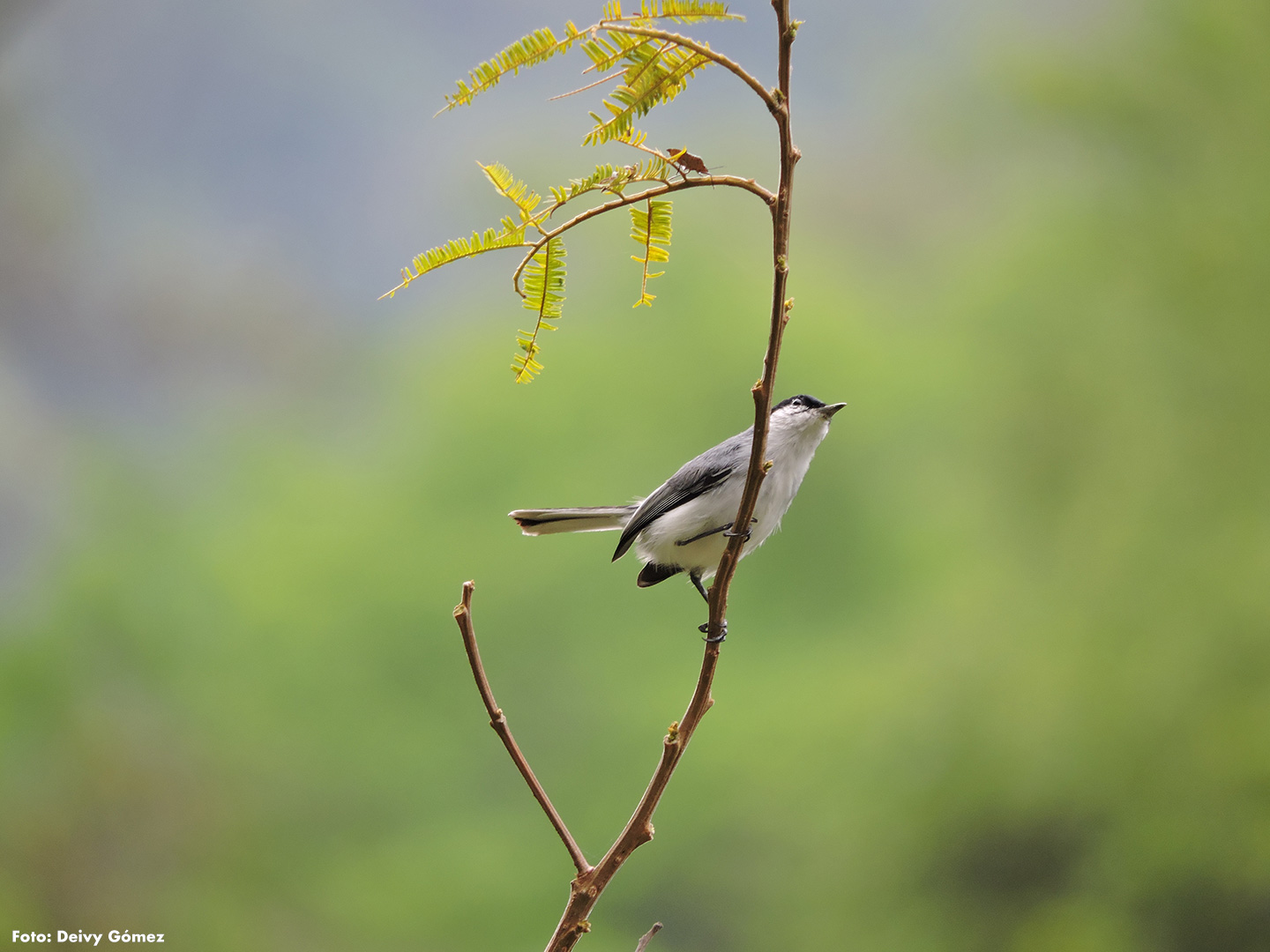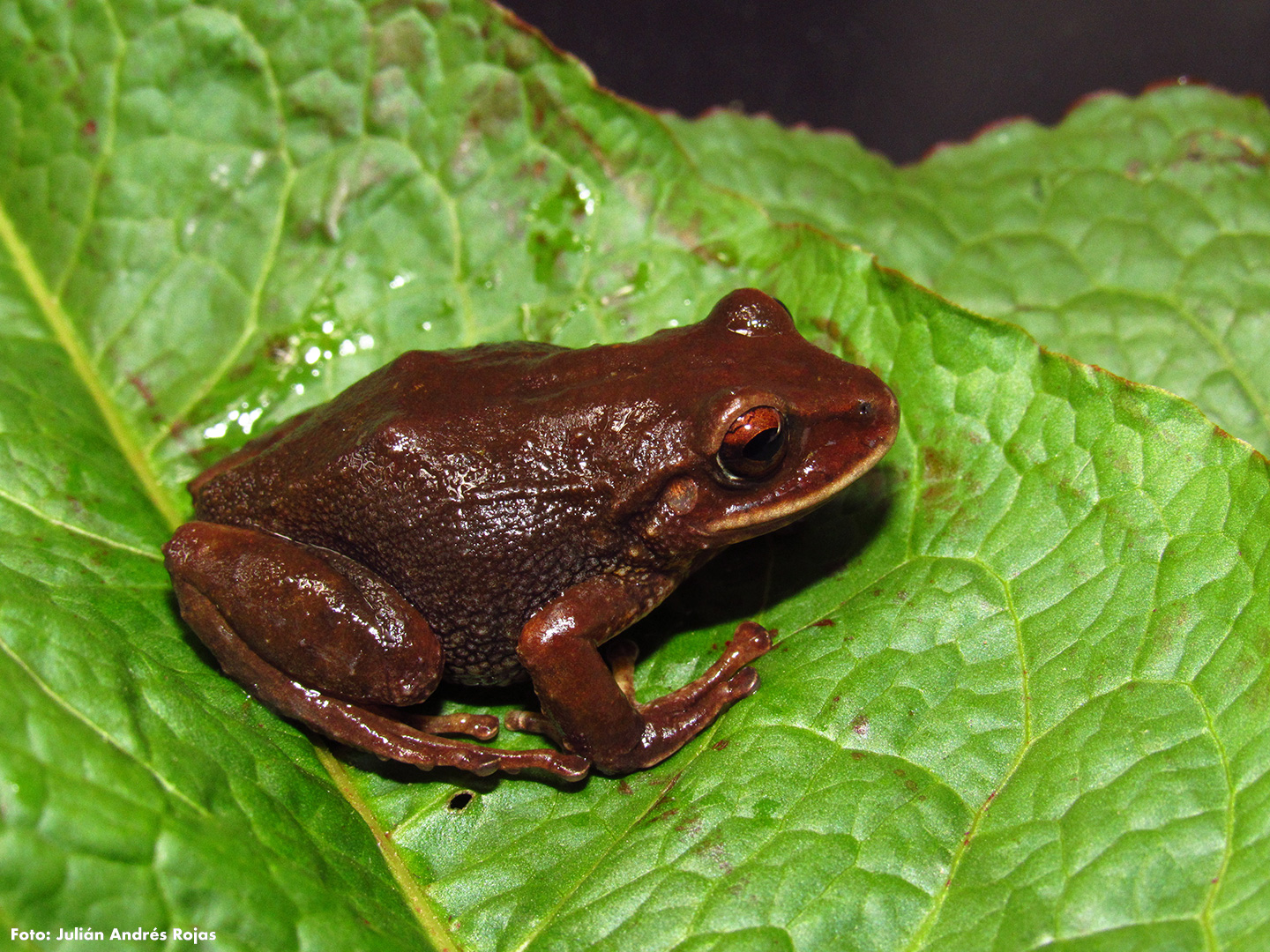In the midst of the identification of the Ecological Structure (conservation area network) for this part of the territory of the Department of Caldas (Colombia), which serves as a basic input for land use plans, researchers identified 24 species of amphibians, 227 of birds, 14 of reptiles, 53 of mammals, 64 of bees and 439 of plants, despite the fact that only 20 percent of the original natural ecosystems survives in this subregion. Identifying the species that share space with the communities, is decisive for the construction of a sustainable environment.
 Polioptila plumbea
Polioptila plumbea
The region where the municipalities of Aranzazu, Pácora, Salamina and Aguadas, in the Department of Caldas (Colombia) are located, has been extensively transformed in the last 350 years.
Today, a large part of this territory belongs to the highly developed agricultural zone of the Eje Cafetero, with many coffee and avocado plantations and livestock farming or pastures, among other productive systems. Due to these human-made changes, only 20 percent of the natural ecosystems of the region remains, a fifth part of what originally existed, supported in only two Protected Forest Reserves (Tarcará and El Diamante) and a Soil Conservation District (El Gigante). However, in spite of all this agricultural development, the biodiversity of fauna and flora endures in the scarce space available and stands out due to its heterogeneity.
The above was observed during the process of identification of the Ecological Structure of the subregion Norte de Caldas, a work accomplished by WCS Colombia in cooperation with the Regional Environmental Authority of Caldas (Corpocaldas), entities that recently reported a huge biological variety in these four municipalities.
During their 31 days of field research, completed almost a year ago, they found 24 species of amphibians, 227 of birds, 14 of reptiles, 53 of mammals, 64 of bees and 439 of plants. These figures are not conclusive and would certainly increase if monitoring continued. All these figures were obtained in an altitudinal gradient going from 550 meters, in the Río Cauca canyon, to 3750 meters in the summits of the Central Andes Range that include paramos.
This research is not only a huge contribution to the communities, who get to know the wildlife with which they share their territory; it is also the completion of one of the phases of the identification of the Ecological Structure of the subregion Norte de Caldas, which includes other components, among them, considerations to the important areas for ecosystem services and some analyses on deforestation and connectivity. This information is the basis for decision-making on land use that supports the territory’s sustainability.
This is how Silvia Álvarez, WCS Colombia researcher and leader of this process, explains it. She adds that the understanding of the biophysical elements present in the region, consolidates a support to prioritize some zones over others when conservation decisions are taken.
“The Ecological Structure that we have identified occupies approximately 50 percent of the subregion Norte de Caldas. Biodiversity is a resource to identify this structure that, in turn, is the basis for territorial planning, at municipal or regional scales”, says Silvia.
Three endemic birds
Knowing what we have is the basis to design strategies that enable the protection of our natural patrimony.
And it is already proven that the most diverse municipality, at least in birds, is Aguadas, with 145 species. Then come Pácora with 100, Aranzazu with 93 and Salamina with 68. This information was obtained with recordings of their songs and calls, field observations and some birds were captured with mist nets to measure and identify them, before releasing them back to their habitat. Of the total registered, 14 are continental migratory birds and three can only be seen in the country (endemic): Parker’s antbird (Cercomacroides parker), the Colombian chachalaca (Ortalis columbiana) and the grayish piculet (Picumnus granadensis).
Another 22 are almost endemic to Colombia, such as the black-billed mountain toucan (Andigena nigrirostris), the pale-naped Brush-finch (Atlapetes pallidinucha), the Crimson-rumped toucanet (Aulacorhynchus haematopygus), the western emerald hummingbird (Chlorostilbon melanorhynchus), the black-chested jay (Cyanocorax affini), the black-collared jay (Cyanolyca armillata) and the tawny-breasted tinamou (Nothocercus julius).
“Analyses show that the diversity of birds in the subregion is high, with 16 percent of dominant species, figures that are also an indication of the status of the forests of the region”, says the report. Common sense prevails, as it is obvious that a region in Colombia, the most diverse country in the world in birds (with more than 1900 species) will continue contributing to strengthen those national figures that are a planetary record.
Glass frogs live here
As to amphibians, that were analyzed through daytime and nighttime field work, nearly 3.5% of the total diversity of this fauna group in the country lives in the zone.
The richest family was Craugastoridae (11 species) all belonging to the genus Pristimantis, which represents 45.8% of the total registered. This is a highly diversified group of terrestrial vertebrates that includes frogs that do not require water bodies for reproduction and, due to this, can live in paramos, in high Andean forests or even in tropical rain forests.
Following in representativeness are the Hylidae family that groups tree frogs, with four species (16.6%) and the Centrolenidae family that includes all glass frogs, with three species (12.5%). Three anurans were reported for the first time in Caldas: Pristimantis parectatus, P. scoloblepharus and Trachycephalus typhonius, this latter called common milk frog.
 Pristimantis sp
Pristimantis sp
Results for mammals evidence that bats of the order Chiroptera, with 32 species and the small rodents of the order Rodentia have the greatest diversity. Three endemic species were found, among which the small-eared shrew (Cryptotis medellinius) and the white-footed Handley's mouse (Handleyomys intectus). All of them were captured with mist nets and 30 traps with bait prepared with oatmeal flakes, peanut butter, wheat grain, sardines, banana and mango.
Orchid bees are alive
The research reported a total of 31 genera and 64 species of bees belonging to four of the five families registered for Colombia. The most representative family was Apidae, with 41 species; it includes domestic honeybees, orchid bees, stingless bees and carpenter bees. The Halictidae family, with 18 species, follows; it groups all solitary bees. All of them were followed in the forest, within transects or bands of land 150 meters long, through direct capture with nets or traps with bait prepared with rotting fish or essences.
Other significant findings were among reptiles, the majority of the order Squamata; 57.1% of the total were snakes and the remaining 42.9% were lizards. The richest family is Colubridae that groups non-venomous snakes.
Among plants, there is a ‘near threatened’ species (Geonoma undata) and one in the ‘vulnerable’ category: the Andean oak (Quercus humboldtii). Two arborescent ferns (Dicksonia sellowiana and Cyatheaceae sp.) and 62 orchid morphotypes (groups that cannot be differentiated at simple sight) were registered. Orchids are included in Appendix II of the Convention on International Trade in Endangered Species of Wild Fauna and Flora (CITES), and their collection is banned in Colombia to support their conservation in the wild.
With these and other hundreds of data on the table, benefits are abundant: one of them indicates that, from the local land use plans , authorities and researchers could be able to determine how to supply the needs of the communities in the region, while accounting for the ecosystem components and functions that enable life in a territory. Somehow, the challenge for this region of Caldas will be the construction of a functional landscape in which each part, whether a group of plants or a group of animals, gains importance in the design or creation of a viable environment that does not forget its inhabitants.
 Anolis auratus
Anolis auratus
The following researchers participated in the identification of biodiversity in the Subregion Norte de Caldas: Víctor Rincón Parra, Andrés Felipe Bohórquez, Eliana Rincón Cifuentes, Julián Andrés Rojas, Mónica Rodríguez, Tatiana Velásquez and Yuli Paulina Ramírez. Students from the Universidad de Caldas also joined the team during field surveys.